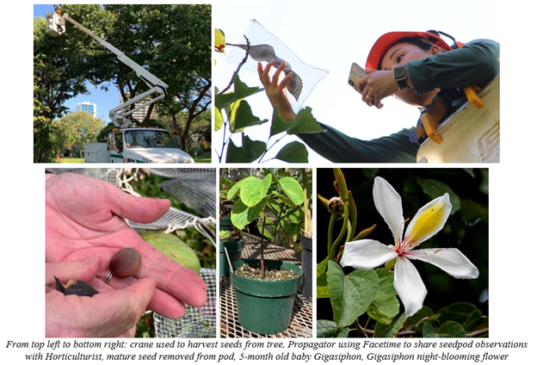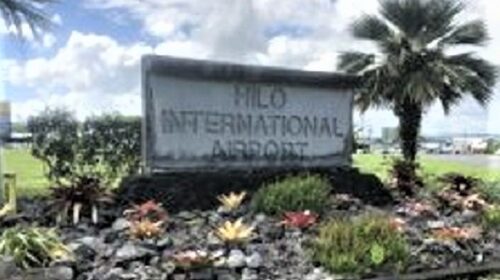Propagation of critically endangered tree continues amid global pandemic
As the Honolulu Botanical Gardens and City parks remain closed to the public amidst the global Coronavirus pandemic, Honolulu Department of Parks and Recreation staff continue to fulfill their duties to maintain, improve, and conserve our shared spaces.
Recently at Foster Botanical Garden, those efforts came to fruition for a critically endangered tree known as the Gigasiphon, as garden staff successfully harvested dozens of the tree’s seeds in an effort to propagate the rare species.
“It’s like seeing a unicorn!” said Joshlyn Sand, Director of the Honolulu Botanical Gardens, referring to the Gigasiphon. “In the wild you are going to see 30 of these trees across Kenya and Tanzania. It’s very, very rare, and the flower is amazing! It is about eight inches across and it is white with a golden center.”
Contributing to its unique status, this 52-year-old exceptional tree is the largest cultivated Gigasiphon in the world. Measuring an estimated 35’ tall with a crown of over 25’.
Unfortunately, propagating this tree has been challenging. Along with borer pests that can damage the tree itself, staff found that Rose-ringed Parakeets love to eat the seeds before they are mature enough to be gathered. The Parakeets have proven to be very persistent in their hunt. Last year garden staff installed cages on the young seedpods to protect them. However, the invasive birds were able to penetrate the cages and consumed nearly all the seeds before they matured, requiring garden staff to adapt their tactics.
“So last fall we put a different type of construction on the cages, with a much finer gauge,” Sand said. “Then we closed them off as tight as we could, and we had success!”
With the cages successfully protecting the seeds, another obstacle presented itself. How can multiple garden staff work side-by-side to harvest the mature seeds in this time of social distancing? Technology provided the answer to this problem, allowing our garden Horticulturist to assist the Propagator with picking the right seeds.
“So what our Propagator did was call the Horticulturist on Facetime,” said Sand. “They were able to go around the tree in the bucket truck, take a look at the seeds, shake them, and judge the feel before opening up a seed to show her that it was brown and ready.”
From this most recent seed harvest, 10 to 15 of the seeds will be sent to the Naples Botanical Garden in Florida, with others slated for other local gardens and arboreta.
Luckily the few seeds gathered last year have shown promise, with garden staff currently caring for a 5-month old baby Gigasiphon. They hope this process can repeat itself with similar success. “So what we’re going to do is gather again, and again, and again every season and keep harvesting,” said Sand. “Other than a few cases where the plants are extinct (only grown in cultivation), and a lot of our Hawaiian flora, this is really about as rare as it gets. If we can get it right, we can get some of these in a number of locations and more here as well.”




